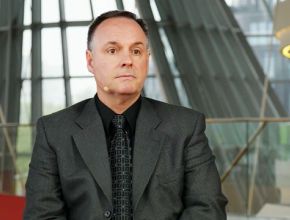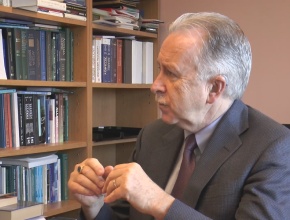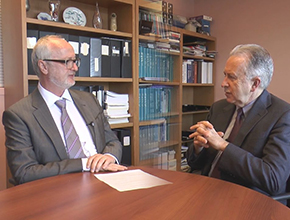Roman Jaeschke: Good morning. I would like to introduce to you Professor Andreas Freitag from McMaster University. Professor Freitag is the head of the critical care at Hamilton Health Sciences as well as our main person running the cystic fibrosis (CF) program. I would like to talk to you, Andy, about CF today. How long have you been dealing with this particular condition?
Andreas Freitag: Good morning Roman. I have been in CF now for 20 years.
RJ: Any milestones, any observations? How did the field change over that span?
AF: I can say – because I am an adult trained respirologist and intensivist – when we all went through a medical school, we thought CF was a fatal disease, we thought it was predominantly a pediatric disease. In the adult world, we had absolutely no clue about the disease and how to treat it from A to Z. But when people started to look at what were the important things, even though they did not understand what the disease was, they understood what the end-organ damage and the end-organ effect was. Pancreatic insufficiency, nutritional deficiencies, opportunistic pneumonia, and getting into problems with progressive declining lung function and premature death related to respiratory failure. What the pediatric world did is they concentrated on all those aspects: how can we actually improve nutrition, how can we prevent malnutrition, how can we actually use pancreatic enzymes to facilitate all of that. Nutrition was extremely important; that was the first milestone, because we know that when the children were better nourished, they grew better. Their bone function was better, their lung function was better, they had less problems in terms of underlying infection.
Point two was that from a respiratory perspective they started to realize that these children were developing infections early on. And so the use of antibiotic therapy, and particularly the use of inhaled antibiotics against Pseudomonas aeruginosa, I think made a big difference from that perspective. All of the sudden, they were treating them much more aggressively. What people thought was colonization in fact was chronic infection. And I think they are quite right: when you treat a chronic infection, you reduce the burden of infection, inflammation, you allow kids’ lungs to grow better, and you actually have less decline in terms of lung function. That truly has been seen over the course of the last 20 to 25 years.
The third part of it, which is the newer part of it, is looking at what are the therapies now that correct the actual CF gene mutation. 25 years ago in Toronto, with a collaboration in the United States, they discovered the CF gene. That was a big milestone, because once they actually knew what the CF gene was, the question is how can we fix this gene, how can we actually correct or potentiate its end-organ effect.
So there are two parts of this. The first part is that just good nutrition, treating individuals from a respiratory perspective, and providing health care in a multidisciplinary way has made a huge difference. When I started out in Canada, I think the mean age of survival was around 25. It is now 54 in Canada, and most of that has been relegated to paying attention to problems and being more proactive, as opposed to reactive, to underline end-organ damage and try to prevent exactly that. How do we do that best? Health-care teams. I think expertise does matter and I mean expertise not just from a physician perspective: nursing, respiratory therapy, occupational therapy, dietitian, all of those things and multidisciplinary approach to that, concentrating on their aspects of their care and expertise, really has made a difference. Why do we say that? Because when you look at CF patients that are not treated in a CF center versus patients that are treated in a CF center, uniformly the patients in CF center do better.
RJ: You mentioned one component here, you mentioned antibiotic use. Could you expand on it a little bit? In later stages, when Pseudomonas is an almost constant presence, what do we practically do?
AF: The common things are this: number one, because these children are seen quite frequently, every 3 months as a routine in the clinic, they do constant surveillance. In children, a lot of times they do throat swabs, and as you get older – hopefully if they can actually have some sputum that they can produce – they analyze that and see which bugs are common in that scenario. Historically, the bugs that were common were things that cause normal low respiratory tract infections, including Staphylococcus aureus. Having said that – we are not really sure why this is but there is a variety of theories behind this – these children, because they develop bronchiectasis, would develop problems with P aeruginosa and there is a variety of reasons why they develop Pseudomonas. But having said that, if you identify P aeruginosa, the recommendation now and the evidence and the experience is, you eradicate it.
So at the first contact with P aeruginosa it does not matter how well or how sick you think the child is – you actually treat them. And how do we treat them? It is very simple. Most of the times they get placed on inhaled tobramycin, Tobi, 300 mg nebulized twice daily for a month, and that has been demonstrated to actually eradicate the Pseudomonas an excess of 70% or 80% of the time. You simply follow them along and see whether or not they develop Pseudomonas again. If they do, it is a reinduction-type therapy. Having said that, for me, I see a lot of patients who have been chronically infected for several years. That is more about damage control. And that is where use of chronic suppressive inhaled antibiotics comes into play. Tobramycin is the granddaddy of it all, we have been using that now for an excess of 30 years. First the intravenous preparation, and now there are newer forms of tobramycin. It is highly effective: you get high levels in the sputum, high levels in the airways, very little toxicity associated with inhaled tobramycin both short- and long-term, and it actually reduces, but probably does not cure, the underlying chronic infection. By reducing the infective burden, you reduce inflammation, you reduce airway damage, and you reduce infective exacerbations, hospitalization, and improve lung function.
RJ: And you use it as a single agent?
AF: Usually we do. The answer is that even if you are having individuals that have got multiresistant P aeruginosa, it is still worthwhile trying inhaled tobramycin because two-thirds of those patients will actually remain stable and respond to that. Just because it is resisting in a Petri dish does not necessarily mean it is not going to be effective. But everybody is an N of 1, and so what we usually do is we put them on inhaled tobramycin on a cyclic basis. The studies have used sort of a month on, month off, month on, month off. The reason for that was high concentration, short pulses, reduce the burden of Pseudomonas but do not try to get into problems with resistance by using a low dose or prolonged use of inhaled. That is the rule, there are exceptions to that.
There are other, newer forms of inhaled antibiotics that can be used for treatment of Pseudomonas when that is not effective. In the UK, as an example, they use a lot of colistin, colimycin, polymyxin, as adjuvant or they use it basically instead of tobramycin. We also have Cayston, or aztreonam, which has been shown to be effective in terms of treating P aeruginosa. Looking at the resistance patterns and mixing it up or sort of cycling your antibiotics has now become a very effective strategy at chronic Pseudomonas infection, eradication or control.
RJ: Last question. Where do you see the future of treatment going?
AF: This is a revolutionary time in the CF world. I mentioned all the treatments that we did was to deal with the end-organ effects. Right now, however, we have got new products that have come out that are looking at the genetic mutations. In the CF world, knowing the gene of the patient matters. Now we are doing genome therapy on an individual basis. What your gene mutation is matters, because there are drugs that have been designed to specifically either correct or potentiate the effects of the genetic mutation. What that means is that if you can actually promote more of the cystic fibrosis transmembrane conductance regulator (CFTR) protein to the receptor, the receptor is going to work better, or if you can fix the receptor to stabilize it so that the protein can actually do what it does, it translates in terms of reduction of symptomatology, improvement of lung function, reduction in exacerbations.
This is going to be extremely important, especially in pediatrics, because most of these individuals have normal, near-normal lung function and otherwise are functioning normally. If you know what their genotype is and you actually institute some of these drugs, which are very well tolerated and have been shown to be effective, the answer is that that is going to change their whole morbidity and mortality specifically related to respiratory lung disease.
RJ: So the future is brighter.
AF: Future is much brighter. The challenges are that these medications are extremely expensive. But, like anything else, hopefully what will happen is the expense will go down and it is not going to be a huge burden in certain countries, but it will be a big problem in other countries. Once again, it all depends philosophically whether or not publicly funded agencies will in fact pick up the tab for gene modifier therapy.
RJ: Thank you. I hope the future will get brighter, or at least brighter and cheaper.
AF: It will.
RJ: Thank you.
AF: Thank you, Roman.
 English
English
 Español
Español
 українська
українська








